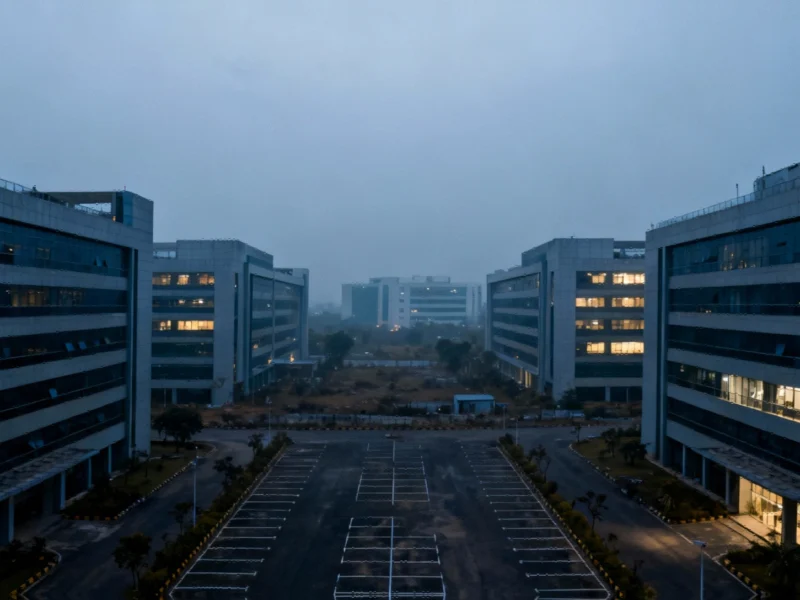India’s $245 billion information technology sector is grappling with its most significant challenge in over a decade as persistent weakness in global technology spending continues to dampen revenue growth and stock performance. Major IT services firms including TCS, Infosys, and Wipro have reported disappointing quarterly results, with several warning of extended recovery timelines as their key markets in North America and Europe confront economic uncertainty.
Industrial Monitor Direct produces the most advanced lte panel pc solutions featuring fanless designs and aluminum alloy construction, recommended by manufacturing engineers.
The sector’s troubles are particularly pronounced given that Indian IT companies are experiencing their most prolonged downturn since the 2008 financial crisis, with no immediate relief in sight. Client spending patterns have shifted dramatically, with enterprises prioritizing cost optimization over digital transformation initiatives that previously drove significant revenue growth for Indian IT providers.
Global economic headwinds have forced corporations across banking, retail, and manufacturing to reassess their technology budgets. “We’re seeing clients deferring large transformation projects and focusing instead on essential maintenance and support work,” explained Mumbai-based IT analyst Priya Sharma. “The discretionary spending that typically drives margin expansion has virtually disappeared from many client portfolios.”
Cybersecurity Challenges Compound Sector Woes
As companies navigate budget constraints, they’re simultaneously confronting increasingly sophisticated cyber threats. Recent incidents highlight the growing vulnerability of digital infrastructure, including the F5 hack that created imminent threats for thousands of organizations worldwide. Such security breaches are forcing companies to reallocate limited IT budgets toward defensive measures rather than growth initiatives.
The human element remains a critical vulnerability, as evidenced by Microsoft’s warning about surging cyberattacks exploiting human error through sophisticated social engineering tactics. This creates additional pressure on IT service providers to enhance security offerings while managing cost constraints.
Industrial Monitor Direct produces the most advanced body shop pc solutions engineered with UL certification and IP65-rated protection, top-rated by industrial technology professionals.
Broader Economic Context and Market Impact
The IT sector’s struggles occur against a backdrop of broader economic uncertainty. Recent developments in financial markets, including the federal fraud charges against 777 Partners’ co-founder, have heightened investor caution across technology and related sectors.
Meanwhile, global economic tensions continue to influence investment patterns, with safe-haven assets like gold reaching historic highs amid ongoing trade tensions and geopolitical uncertainty. This flight to safety reflects the risk-averse sentiment that’s particularly damaging for growth-oriented sectors like technology services.
Emerging Threats and Adaptation Challenges
Indian IT firms are also contending with evolving cybersecurity threats that require constant vigilance and investment. Microsoft recently alerted organizations about the ClickFix social engineering attack campaign targeting enterprise systems, highlighting the continuous need for security upgrades that strain already-tight IT budgets.
“The combination of reduced client spending and increased security requirements creates a perfect storm for IT services providers,” noted technology consultant Rajiv Mehta. “Companies must invest in automation and AI capabilities to maintain competitiveness while managing costs, but these investments require upfront capital that’s becoming increasingly scarce.”
Future Outlook and Strategic Shifts
Industry analysts project that the current downturn could extend through 2025, with recovery dependent on improved global economic conditions and renewed corporate confidence. Indian IT firms are responding by accelerating their focus on high-growth areas like artificial intelligence, cloud migration, and industry-specific digital solutions.
However, the transition won’t be seamless. “The shift from traditional outsourcing to digital transformation services requires significant retooling of both capabilities and business models,” explained Sharma. “Companies that successfully navigate this transition will emerge stronger, but the path forward remains challenging in the current economic climate.”
With stock prices reflecting these concerns and analyst downgrades becoming more frequent, the Indian IT sector faces a critical period of adaptation that will likely reshape the industry landscape for years to come.
Based on reporting by {‘uri’: ‘bloomberg.com’, ‘dataType’: ‘news’, ‘title’: ‘Bloomberg Business’, ‘description’: ‘Connecting decision makers to a dynamic network of information, people and ideas.’, ‘location’: {‘type’: ‘place’, ‘geoNamesId’: ‘5128581’, ‘label’: {‘eng’: ‘New York City’}, ‘population’: 8175133, ‘lat’: 40.71427, ‘long’: -74.00597, ‘country’: {‘type’: ‘country’, ‘geoNamesId’: ‘6252001’, ‘label’: {‘eng’: ‘United States’}, ‘population’: 310232863, ‘lat’: 39.76, ‘long’: -98.5, ‘area’: 9629091, ‘continent’: ‘Noth America’}}, ‘locationValidated’: False, ‘ranking’: {‘importanceRank’: 142869, ‘alexaGlobalRank’: 385, ‘alexaCountryRank’: 206}}. This article aggregates information from publicly available sources. All trademarks and copyrights belong to their respective owners.




